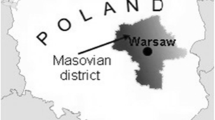Abstract
The adsorption of zinc and lead on hair was dependent on the acidity of the hair and/or the medium in which the hair sample was immersed, suggesting that hair is an ion exchanger. The pKa was estimated to be between 4.5 and 5.0. The coexistence of mercuric ion or PCMB reduced zinc adsorption by only a few percent, whereas zinc inhibited mercuric ion adsorption to a greater extent. These facts suggest that the binding sites in hair for metals are located on functional groups like carboxyl groups rather than sulfhydryl groups.
The removal and/or elution of metals from hair were observed for 18 elements by various washing procedures. By treating hair with a water solution of detergent, alkaline metals were eluted to a great extent, whereas alkaline earth metals were eluted to some extent. The other metals did not vary with any procedures tested.
Similar content being viewed by others
References
K. M. Hambidge,Am. J. Clin. Nutr. 27, 505 (1974).
R. B. Bradfield, A. Cordano, J. Baertl, and G. G. Graham,Lancet 16, 343 (1980).
B. M. Anderson, R. S. Gibson, and J. H. Sabry,Am. J. Clin. Nutr. 34, 1042 (1981).
L. Kopito, A. M. Briley, and H. Shwachman,J. Am. Med. Assoc. 209, 243 (1969).
L. Amin-Zaki, inHealth Evaluation of Heavy Metals in Infant Formula and Junior Food, E. H. F. Schmidt and A. G. Hildebrandt, eds., Springer-Verlag, NY, pp. 161–167, 1983.
M. Castro-Magna, P. J. Collipp, S. Chen, T. Cheruvanky, and V. T. Maddaiah,Am. J. Dis. Child 135, 322 (1981).
R. F. Borgman, S. F. Lightsey, and W. R. Roberts,Roy. Soc. Health J. 102, 1 (1982).
J. Holzbecher and D. E. Kyan,Clin. Biochem. 15, 80 (1982).
R. S. Gibson, B. M. Anderson, and C. A. Scythes,Am. J. Clin. Nutr. 37, 37 (1983).
R. W. Phelps, T. W. Clarkson, T. G. Kershaw, and B. Wheatley,Arch. Environ. Health 35, 161 (1980).
K. Nishiyama and G. F. Nordberg,Arch. Environ. Health 25, 92 (1972).
Y. Marumo and S. Seta,Eisei Kagaku 27, 381 (1981).
L. C. Bate,Int. J. Apple. Radiat. 17, 417 (1966).
K. M. Hambidge, M. L. Franklin, and M. A. Jacobs,Am. J. Clin. Nutr. 25, 384 (1972).
T. Hinners, W. Jerrill, J. Kent, and A. Colucci,Environ. Health Perspect. 8, 191 (1974).
IAEA,IAEA/AG-53, International Atomic Energy Agency, Vienna (1976).
Y. Marumo,Eisei Kagaku,29, 192 (1983).
Author information
Authors and Affiliations
Rights and permissions
About this article
Cite this article
Mikasa, H., Suzuki, Y., Fujii, N. et al. Adsorption and elution of metals on hair. Biol Trace Elem Res 16, 59–66 (1988). https://doi.org/10.1007/BF02795334
Received:
Accepted:
Issue Date:
DOI: https://doi.org/10.1007/BF02795334




